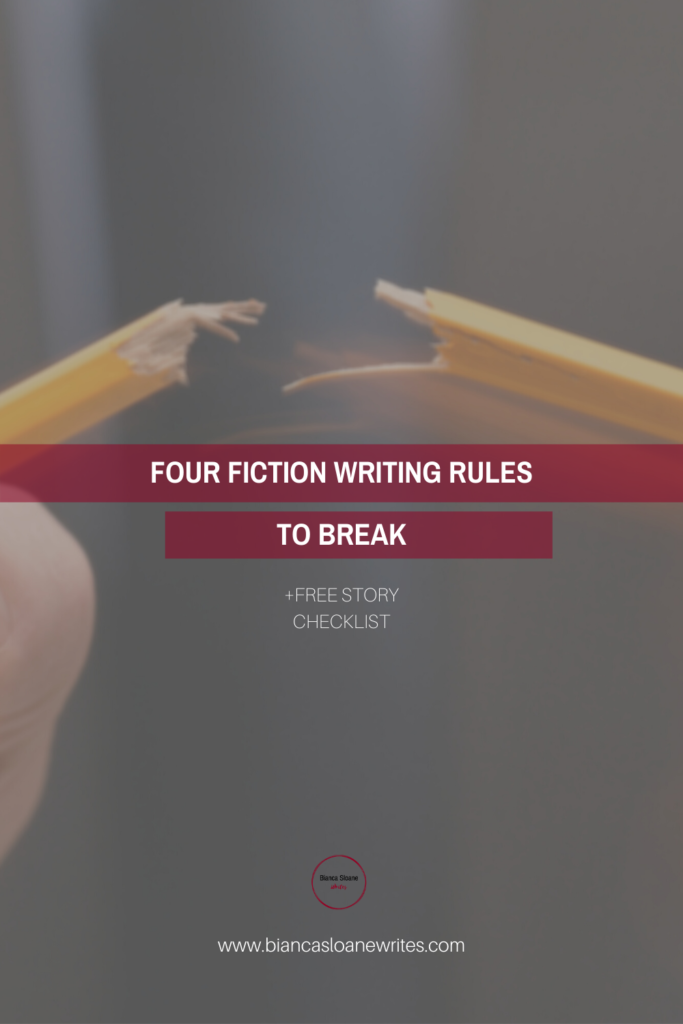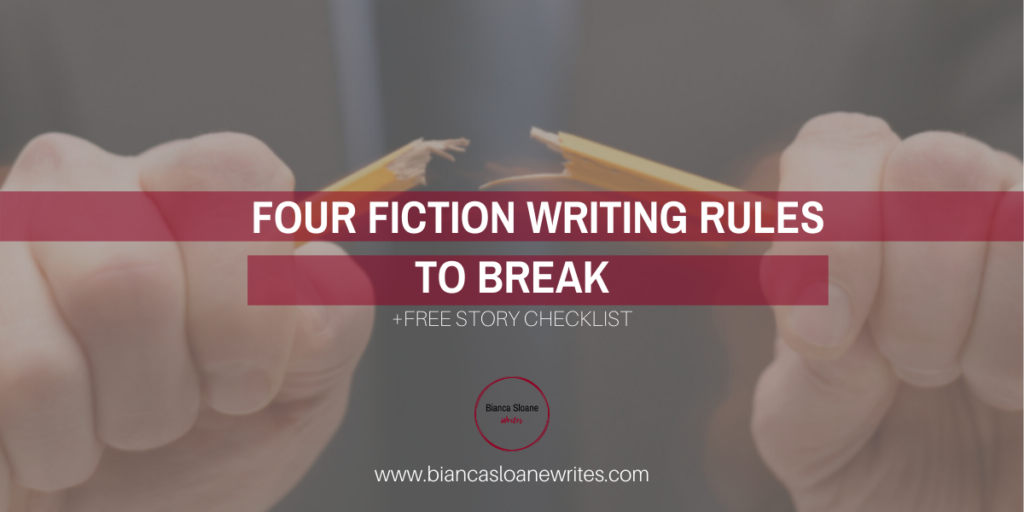Four Fiction Writing “Rules” to Break
Click here to read my post on “Five Fiction Writing Rules to Follow.”
Anyone who writes fiction, be it newbie or vet, knows all too well about the “rules” of writing. It can be especially daunting when you’re starting out to try to commit to memory the seemingly never-ending list of do’s and don’ts: character drives plot, show not tell, make dialogue realistic, but not too realistic, use three-act story structure, kill the adverbs – just to name a few. Adding to the confusion is when your writing heroes break the very rules the experts say to follow.
The truth is, some fiction writing rules are meant to be broken and you get to figure out which ones to break and which ones to leave in tact. Tricky stuff.
Here are four writing rules I personally have bent (broken) and recommend you do, too:
1) Write What You Know
This one can be especially binding, because if you don’t know anything, you’re screwed.
Mystery writers can’t go around committing murders and science fiction writers can’t hop in their spaceships and hit warp speed toward the outer realm. As writers, research and our imaginations are among the most vital tools in our toolbox. If writers ONLY wrote about what they knew, there’d be a whole lot of boring, one-dimensional novels out there. Research helps us uncover information on topics we don’t know anything about, while our imagination fills in the blanks.
Don’t be intimidated by your limited knowledge about a topic. Read, travel, conduct interviews, scour the Internet, visit the library – and make up the rest!
2) Don’t Start Your Story with a Prologue
Prologues get a bad rap, mostly because they’re used incorrectly (Elmore Leonard made prologues No. 2 on his list of writing don’t’s). The biggest misfire is using them as a dumping ground for reams of dull exposition or giving the whole story away.
However, when done right, prologues can start a story with a bang. For example, in the opening scenes of “American Beauty,” Lester Burnham tells us he’ll be dead in a year. We keep watching because we want to find why, how, and who-did-it. In “Sunset Boulevard,” when we see William Holden’s bullet-ridden body floating in the pool, we want to know who he is, who shot him and why. The classic “Twilight Zone” episode, “To Serve Man,” shows an agitated Mr. Chambers being held prisoner on a spaceship, warning us this was how nightmares began. We keep watching to learn how he came to be imprisoned and exactly what his nightmare is.
Like any device, when done correctly, opening your book with weather can masterfully set the tone for the rest of the story.
If a prologue serves your story – REALLY serves the story – go for it. For example, prologues are pretty standard in mystery/suspense stories, as it’s usually when the crime happens.

Remember, though, a prologue shouldn’t be used for unnecessary exposition, but rather as an intriguing set up for the action to come. A good rule of thumb? If you can take the prologue out and it doesn’t impact the rest of the story, kiss it goodbye.
3) Develop an Outline
This is really one of those “rules” that can be bent, broken, stretched, and stomped on. Or followed to the letter. It’s up to you. The truth is, outlining is totally subjective. You’ll need to decide if you’re a plotter (someone who outlines every aspect of the story before they write it), a pantser (fly by the seat of your pants storyteller, or someone figures out the story as they go along) or if you’re a hybrid (I refer to myself as a plotser. I don’t do firm outlines, but use what I call plot points, or bullet points of the major events in the story, with a sentence or two of description for each).
Everyone’s approach to outlining is different. Years ago, I attended a reading/signing/Q&A with Gillian Flynn and during the event, she discussed her writing process. She termed herself a “highly inefficient writer,” who often doesn’t know whodunit even when she’s thirty pages from the end. In his book on the craft, “On Writing,” Stephen King dubbed himself a “situational” writer, shunning heavy plotting in favor of intuition. Nora Roberts says she simply sits down and writes based on a loose outline she has in her head (I was SHOOK when I read she writes all her books on WordPerfect. As in DOS. Mind. Blown.).
On the other end of the spectrum, Jonathan Kellerman and James Patterson are devotees of the outline, but stress they aren’t afraid to deviate from it. Joy Fielding does a narrative outline before she starts. Laura Lippman outlines her stories after she writes them, using color-coded charts and graphs.
Bottom line, as mentioned above, do what feels natural to you. Don’t be afraid to experiment with a variety of methods until you find the one that fits.
Don’t be intimidated by your limited knowledge about a topic. Read, travel, conduct interviews, scour the Internet, visit the library – and make up the rest!

4) Don’t Start with Weather
Another entry from Elmore Leonard’s famed list of writing rules and honestly, it’s a head-scratcher for me. I guess one too many “it was a dark and stormy night” or “it was a sunny day” openers birthed this particular “rule.”
Here’s the thing to remember about opening your book with weather . . . it’s not really about the weather. In other words, don’t open your book with weather just for the hell of it (dark and stormy nights come to mind). Make it mean something. Make it count. Use it to establish mood, introduce conflict, juxtapose it against your character’s current state of mind. Like any device, when done correctly, opening your book with weather can masterfully set the tone for the rest of the story.
Here are just a few examples of books that open with weather and do it well:
“It was a bright cold day in April, and the clocks were striking thirteen.” — 1984, George Orwell
“At first the breeze was no more than a long sigh, breathing through the Texas high country as though expressing some sadness attendant to Nature itself.” – The Forbidden Door: A Jane Hawk Novel, Dean Koontz
“The Santa Anas blew in hot from the desert, shriveling the last of the spring grass into whiskers of pale straw.” – White Oleander, Janet Fitch
“He came to lying on his back, with sunlight pouring into his face and the murmur of running water close by.” – Pines, Blake Crouch
“Staring out at the summer rain, Sydney Wells felt as though she were swimming underwater.” – Fall From Grace: A Novel, Danielle Steel
There are LOTS of great ways to open a book – including weather. Just don’t deliver weather reports.
What are some fiction writing rules you’ve broken in your own stories?

Pin this for later!

